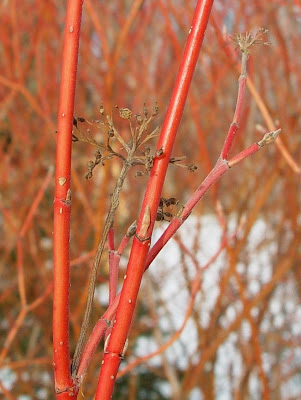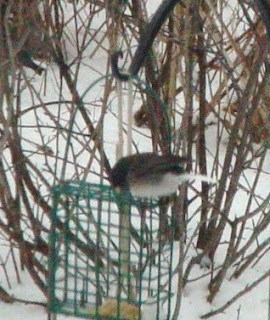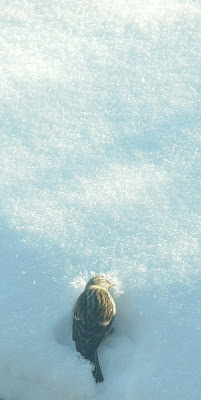4/20/2013
really red bellied
We've seen both the male and female Red-bellied Woodpeckers at the edge of the wild woods this winter. Usually, their red belly is not easily visible. However, on a recent morning the male came out of the woods for suet and showed us his full colorful plumage. It is courtship season for Woodpeckers!
woody trees
4/17/2013
earliest crop
The rhubarb stems push their way up through the mulch towards the light, intending to unfurl their beautiful textured leaves as the sun beckons. Rhubarb is one of our first crops each Spring.
4/16/2013
it may seem like winter . . .
4/11/2013
Junco gathering

We remember being confused in January when it was 40F. Now, in mid-April, we're even more confounded by several inches of heavy wet snow. There are more Juncos at the edge of the woods -- probably the ones that wintered here as well as some on their way from southern Minnesota back up north where they usually nest. I put out a plate of seed for them to eat heartily on their way. One of them seemed to have a white tail, rather than the typical long dark one. Looking closely, it seems to be missing those dark feathers and we are seeing only the white rectrices (Latin for "helmsman"). This bird may have trouble migrating without all his tail feathers which help the bird to brake and steer in flight.
4/10/2013
Fox Sparrows
Among the Juncos and Chickadees, today there were two Red Fox Sparrows searching for seeds on the ground at the edge of the woods. They find insects, larvae, and scale insects in leaf litter with a hop forward and an immediate hop back, during which they simultaneously scratch both feet backwards. Several inches of snow this week may be delaying migration of these and others birds who go back up north to nest and raise their young.
3/26/2013
molting feathers
Another sign of Spring . . .
the male Goldfinches Spinus tristis are beginning to molt into their bright yellow feathers, a few at a time, so they will be handsome for mating and nesting season in the coming summer.
3/25/2013
water for birds
A pair of Red-Bellied Woodpeckers Melanerpes carolinus occasionally come out of the woods to eat suet and drink at the water bowl. The female has less red on her head than this male, but the female has more red feathers apparent on her belly.
3/21/2013
Cedar Waxwings
Flocks of Cedar Waxwings Bombycilla cedrorum wander together to find berries, their main food year around. They typically feed while perched on a twig, but they’re also good at
grabbing berries while hovering briefly just below a bunch.
These seven announced themselves mid-morning with high whistles and sat up in the elm trees to rest a while. When no berries are available, they'll do acrobatics in the air to catch and eat flying insects. Here, they may have been finding insects or larvae among the tree buds.
According to Cornell Lab of Ornithology's allaboutbirds.org, the Cedar Waxwing’s name comes from their appetite for cedar berries in winter.
These seven announced themselves mid-morning with high whistles and sat up in the elm trees to rest a while. When no berries are available, they'll do acrobatics in the air to catch and eat flying insects. Here, they may have been finding insects or larvae among the tree buds.
According to Cornell Lab of Ornithology's allaboutbirds.org, the Cedar Waxwing’s name comes from their appetite for cedar berries in winter.
3/19/2013
nest boxes
wintery Spring
 Away for all of February, we returned thinking Spring would be extremely evident in the wild woods. Not so, this year! Late March already, and the snow keeps coming.
Away for all of February, we returned thinking Spring would be extremely evident in the wild woods. Not so, this year! Late March already, and the snow keeps coming. The birds are still spending most of their energy each day seeking seeds and insects, even if they have to sift through the snow for food. Courtship and nesting will have to wait.
(left) Common Redpoll
Dark-eyed Junco (right)
1/30/2013
January woodpecker
This female Hairy Woodpecker is finding insects or larvae in the folds of bark on the elm tree. She can probe into the crevices with her long bill, and her strong tail helps her balance against the force of her pecking.
1/22/2013
dogwood in January

 Two varieties of dogwood brighten the edge of the wild wild woods. Cornus alba 'Ivory Halo' displays dark rich red twigs in the winter. Cornus sericea 'Cardinal' glows with bright crimson bark, quite brilliant in the sunlight against the snow. They both provide a fine tangle for the red feathered birds (Cardinals, House Finches, Redpolls) to hide in plain sight.
Two varieties of dogwood brighten the edge of the wild wild woods. Cornus alba 'Ivory Halo' displays dark rich red twigs in the winter. Cornus sericea 'Cardinal' glows with bright crimson bark, quite brilliant in the sunlight against the snow. They both provide a fine tangle for the red feathered birds (Cardinals, House Finches, Redpolls) to hide in plain sight.
1/11/2013
waterplay 2
40°F is warm for January here. The Bluejays took advantage of the thaw to bathe (and play) in the water bowl.
1/10/2013
nuthatch cache
A new feeder, filled with dried mealworms. Within six minutes, this White-breasted Nuthatch Sitta carolinensis arrived to grab the best ones. Then, I noticed where he was taking them!
1/09/2013
color in the wild woods
 |
| The Mourning Doves Zenaida macroura, usually appearing drab from a distance, are extremely colorful up close and against the white snow. |
| The female Northern Cardinal Cardinalis cardinalis is a study in contrasts with her bright orange beak, orange striped wing primaries, and perky peaked cap. |
| The Dark-eyed Junco Junco hyemalis, in formal black and white, looks striking among the soft colors of the frosted branches and hanging samaras. |
1/04/2013
trees in January
| Maple Acer rubrum buds |
The trees sent out new twigs and lengthened their branches last Summer. During Autumn, leaf buds were set on this new growth.
Now, in January, those buds on the deciduous trees in the wild woods are dormant.
The buds are actually embryos packed into a protective outer scale. Each tree species' buds are a different shape, size, texture, and color.
In Springtime, they will all open to become flowers and leaves.
| Larch Larix laracina buds and cone |
1/03/2013
cold morning comfort

This morning was cold again,
with snow flurries swirling on light breezes.
Two Red-bellied Woodpeckers
Melanerpes carolinus,
Melanerpes carolinus,
one male and one female,
live in the wild woods.
They come to the suet blocks at the
They come to the suet blocks at the
feeder station to load up on fat
and supplement their diet of insects
gleaned from between the crevices of tree bark.
Today, the male rested a while
with his head tucked down
among the feathers on his shoulders.
All we could see of his head was
a small red circle.
Then, he popped his beak out
and took a look around,
making sure all was safe
for a few more minutes of cozy rest.
12/31/2012
post-lunch nap 2
Another day, another hawk. One of the dangers for songbirds at feeder stations is the hawk that knows it is a good spot to prey on smaller birds. While I am sorry to see the little birds threatened, the hawks are also interesting to watch. This Cooper's Hawk Accipiter cooperii appeared around noon, sitting in a tree crotch exposed to the sun. For nearly an hour, he stayed there even though the Chickadees and Finches scolded him continuously. We watched several smaller birds go back and forth between the feeders and branches just six feet from the hawk. Surely they knew he was there. And surely he was not hungry, or there would have been a different scenario.
12/30/2012
would-be thieves
The wild woods is home to many Gray squirrels and a few Red Squirrels. This little guy tries every day to jump from a branch to the bird feeder. But so far, no success.
The squirrels do try to climb straight up the poles to the bird food, but the "slinky" toys suspended on each pole are too scary from below. The squirrels stand at the bottom, climb a bit, reach up, and touch the bottom of the slinky, but run away as soon as it jiggles.
The squirrels do try to climb straight up the poles to the bird food, but the "slinky" toys suspended on each pole are too scary from below. The squirrels stand at the bottom, climb a bit, reach up, and touch the bottom of the slinky, but run away as soon as it jiggles.
12/27/2012
down underwear
When it gets cold near zero F, birds fluff their feathers out to hold their body heat among the down beneath their larger feathers. This little Downy Woodpecker Picoides pubescens was seeking insects along the bark on the Boxelder tree, but paused to rearrange his downy underwear for maximum heat retention.
12/25/2012
Common Redpoll
This week, some Common Redpolls joined the guild of mixed species in the wild woods. Their perky attitude and bright red caps made them stand out among the other finches. Usually nesting in the arctic tundra and boreal forests, they come south for warmth in winter.
12/24/2012
albino House Finch
At first I thought this little round white bird, roosting early this morning among the House Finches, was an owl. But closer inspection through the binoculars make me think it is an albino House Finch.
12/22/2012
rosy finches
There are usually groups of finches in the wild woods. Most often, they are the rosy House Finches and gold or olive Goldfinches. Occasionally, I see Purple Finches among them.
Subscribe to:
Posts (Atom)



















